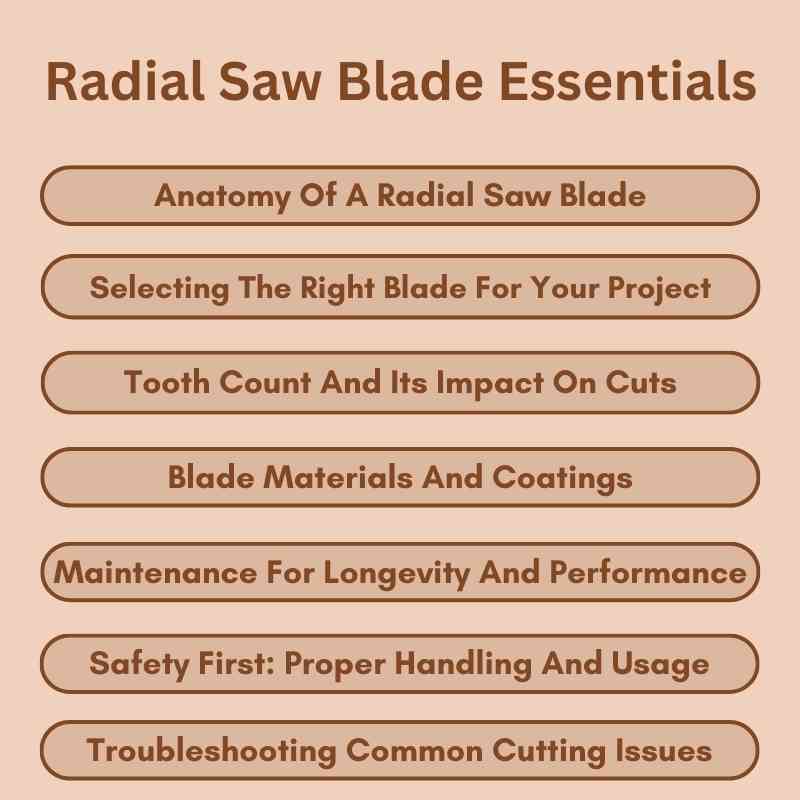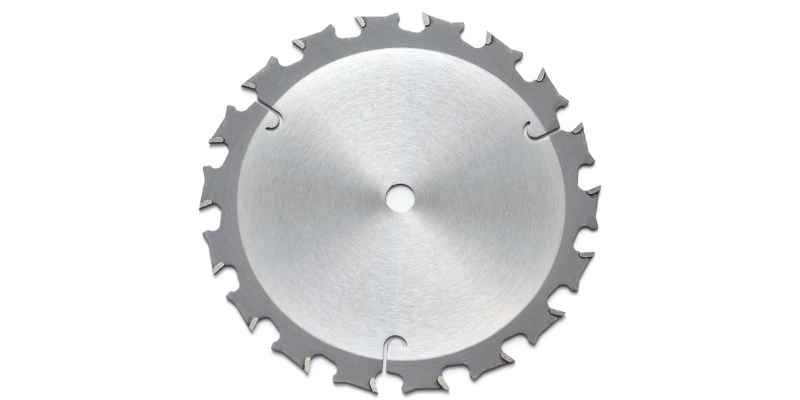A radial saw blade is a specialized cutting tool used in radial arm saws. It allows for precise, angled cuts across various materials.
Radial saw blades are essential for woodworkers and construction professionals. These blades excel in making crosscuts, miter cuts, and rip cuts, offering versatility in woodworking projects. Their unique design features teeth that can efficiently slice through different materials, including hardwood, softwood, and even composite materials.
Choosing the right radial saw blade enhances cutting accuracy and efficiency, making it a vital component in any workshop. Understanding the various types and sizes of radial saw blades helps users select the best option for their specific needs. Whether you’re a hobbyist or a seasoned professional, investing in a quality radial saw blade can significantly improve your craftsmanship.
Anatomy Of A Radial Saw Blade
The radial saw blade consists of key components. The core provides strength and stability. It supports the teeth for cutting. Teeth are vital for the blade’s performance.
Tooth design impacts cutting efficiency. Different configurations serve specific purposes. For example, flat teeth cut quickly through soft materials. Alternate top bevel teeth create smooth cuts in hardwood.
The angle of the teeth affects how the blade behaves. A negative hook angle helps control the cut. A positive hook angle allows faster cutting speeds. Choosing the right design enhances cutting precision.

Selecting The Right Blade For Your Project
Choosing the right radial saw blade is crucial for your project. Different materials require different blade types. For wood, use a blade with fewer teeth. For metal, select a blade with more teeth for a smoother cut.
Blade diameter affects cutting depth. A larger diameter cuts deeper. Arbor size must match your saw for safety and efficiency. Always check both sizes before purchasing.
| Material | Teeth Count |
|---|---|
| Wood | 24-40 teeth |
| Metal | 40-80 teeth |
| Plastic | 30-60 teeth |
Tooth Count And Its Impact On Cuts
Tooth count on a radial saw blade greatly affects the type of cut. A low tooth count blade cuts quickly and is ideal for rough cuts. It removes more material faster but may leave a rough finish.
On the other hand, a high tooth count blade provides smoother cuts. It is perfect for fine woodworking and detailed projects. This blade removes less material, leading to a better finish.
Balancing speed and finish depends on your project needs. Choose a blade based on the desired outcome and material type.
Blade Materials And Coatings
Steel blades are common and affordable. They work well for general cutting tasks. Steel offers good strength but can dull quickly.
Carbide blades are tougher and last longer. They resist wear and heat better than steel. These blades are ideal for cutting hard materials.
| Blade Type | Advantages | Disadvantages |
|---|---|---|
| Steel | Affordable, easy to sharpen | Dulls faster, less durable |
| Carbide | Long-lasting, heat resistant | More expensive, harder to sharpen |
Protective coatings enhance blade performance. They reduce friction and improve cutting efficiency. Coatings also help prevent rust and corrosion.
Common coatings include Teflon and diamond. Teflon reduces friction, while diamond offers superior hardness. Choosing the right coating can improve blade life.
Maintenance For Longevity And Performance
Keeping your radial saw blade clean is vital for good performance. Regular cleaning removes dust and debris. Use a soft brush or cloth to wipe the blade. Avoid using harsh chemicals that can damage it.
For sharpening, use a good quality sharpening tool. Follow the manufacturer’s guidelines for angles and techniques. This helps maintain the blade’s cutting efficiency. Sharpening should occur after every 15-20 cuts or when you notice a decrease in performance.
Always inspect the blade for any damage or wear. Replace the blade when necessary to ensure safety and effectiveness. Proper care leads to better results and a longer-lasting blade.
Safety First: Proper Handling And Usage
Always handle blades with care. Use gloves for better grip and protection. Make sure to keep the blade sharp. A dull blade can cause accidents. Store blades in a safe place away from children.
Preventing kickback is crucial. Always check the alignment before cutting. Keep your hands away from the blade. Use a push stick for safety. Maintain a firm grip on the material being cut. Stay focused and avoid distractions while using the saw.
Troubleshooting Common Cutting Issues
Burn marks on your cuts can signal dull blades. A dull blade creates friction and heat. This heat causes burn marks on the wood. Regularly sharpen your blade to avoid this issue.
Check the alignment of the saw. Misalignment can lead to uneven cuts and vibrations. Ensure the blade is straight and properly installed. Vibration can also occur if the blade is not balanced.
| Issue | Solution |
|---|---|
| Burn Marks | Sharpen the blade regularly |
| Dullness | Replace with a new blade if needed |
| Warping | Check alignment and tighten screws |
| Vibration | Ensure blade is balanced and straight |
Innovations In Radial Saw Blade Technology
Recent advancements in radial saw blade design focus on improved efficiency and precision. Modern blades use high-quality materials to enhance durability and performance. New tooth geometry allows for smoother cuts and less friction. This results in less wear and tear on the blade.
Innovations like laser cutting technology improve accuracy while minimizing waste. Coatings on blades reduce friction and increase lifespan. These changes help professionals achieve better results in less time. The future of precision cutting looks bright with these advancements.

Frequently Asked Questions
What Is A Radial Saw Blade?
A radial saw blade is a circular cutting tool designed for radial arm saws. It features sharp teeth arranged around the perimeter. These blades are used for precise crosscuts and angled cuts in wood and other materials. Choosing the right blade ensures efficiency and quality in your projects.
How Do I Choose The Right Radial Saw Blade?
Selecting the right radial saw blade involves considering the material you’ll cut. Look for blades designed for specific tasks, like ripping or crosscutting. Pay attention to the tooth count and blade diameter. Higher tooth counts offer smoother cuts, while lower counts excel in faster, rough cuts.
How Often Should I Replace My Radial Saw Blade?
You should replace your radial saw blade when it becomes dull or damaged. A dull blade can cause poor cutting performance and increase the risk of accidents. Regular inspection is essential. If you notice excessive burning or jagged cuts, it’s time for a replacement.
Can I Use A Radial Saw Blade For Metal?
Radial saw blades are primarily designed for wood and similar materials. However, specialized blades exist for cutting metal. Ensure the blade is rated for metal cutting to avoid damage and ensure safety. Using the correct blade type is crucial for achieving clean, effective cuts.
Conclusion
Choosing the right radial saw blade enhances your woodworking projects significantly. It ensures clean cuts and improves efficiency. Regular maintenance and proper selection will extend the life of your blade. Invest time in understanding your options for the best results.
Elevate your craftsmanship with a quality radial saw blade today.

